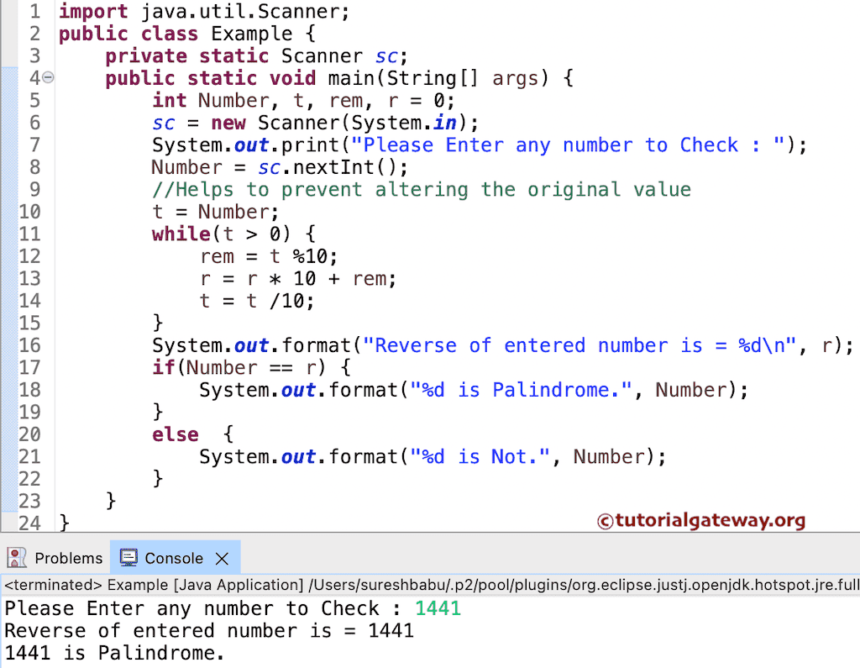Introduction
A palindrome number reads the same forward and backward. In Java, you can check this with code. This guide will teach you clear steps. It uses plain words and small examples. You will see simple Java code. You will get tips and tests to use. I will explain common pitfalls too. The phrase palindrome number in java appears often. That helps you find this article online. But the writing stays natural and helpful. You do not need deep Java experience to follow. We will walk step by step. By the end, you can write code and handle edge cases. You will also learn how to test your work.
What is a palindrome number?
A palindrome number stays the same when you reverse its digits. Examples are 121, 1331, and 7. Non-examples are 123 and 120. The last one is different because of the zero. In Java, we treat digits as numbers or as characters. Both ways work. This section explains the idea in plain words. We will show code later. The keyword palindrome number in java is central to our topic. Keep in mind that negatives are usually not palindromes. A minus sign breaks the symmetry. We will cover that rule and why it matters.
Why check a palindrome number in Java?
People practice palindromes to learn loops and math. Palindrome checks teach digit math and string tricks. They also show edge case handling. You may need a palindrome check in a coding test. You may also want it for a small app. It is a good beginner Java problem. It helps you learn integer handling. It shows how to avoid overflow too. The phrase palindrome number in java shows up in job test lists. That makes this skill useful to learners. You will find this skill handy for interviews and practice. It also helps with algorithm thinking.
Common approaches to check palindrome number in Java
There are a few common ways to check palindromes in Java. The simplest uses strings. You convert the number to text. Then you reverse the text and compare. A more math-focused way reverses digits with modulo. This way uses no extra string memory. Another trick reverses only half the digits to avoid overflow. You can also use recursion. I will show the string and math ways in code. Each way has trade-offs. Some are simpler. Some are faster or safer. We will compare time and space cost soon. The phrase palindrome number in java will appear with each method example.
Method 1 — Reverse the number (math only)
This method uses arithmetic to reverse digits. It uses while, %, and /. It avoids converting to a string. This can be fast and memory light. Here is the idea in steps. Step 1: if the number is negative, reject it. Step 2: build reversed by taking digit = n % 10. Step 3: reversed = reversed * 10 + digit. Step 4: n = n / 10. Step 5: repeat until n is zero. Step 6: compare original and reversed. This checks if they match. This method handles int values. Watch for overflow on large numbers. Below is a compact Java example.
public static boolean isPalindromeMath(int x) {
if (x < 0) return false;
int original = x;
int reversed = 0;
while (x != 0) {
int digit = x % 10;
// check for overflow before multiplying
if (reversed > Integer.MAX_VALUE / 10) return false;
reversed = reversed * 10 + digit;
x /= 10;
}
return original == reversed;
}
Method 2 — Convert to string and reverse
This method turns the number into text. Then you reverse the text and compare. It is easy to write and read. It uses more memory than math. It also avoids manual overflow checks. This is fine for small practice tasks. For large-scale apps, you may prefer the math method. Here are the main steps. Step 1: convert the number with String.valueOf(n). Step 2: make a StringBuilder. Step 3: call reverse() on the builder. Step 4: compare the builder string to the original. This method treats -121 as not a palindrome. The minus sign changes the string. This example shows the code.
public static boolean isPalindromeString(int x) {
String s = String.valueOf(x);
String rev = new StringBuilder(s).reverse().toString();
return s.equals(rev);
}
Method 3 — Reverse half the number (overflow-safe)
This trick only reverses half the digits. It avoids overflow without special checks. The idea is to stop when the reversed half matches or exceeds the remaining half. For odd digit counts, drop the middle digit. This method is efficient and clean. Steps: if x is negative, return false. While x > reversed, move last digit from x to reversed. At the end, check x == reversed or x == reversed / 10. This handles odd-length numbers. It avoids int overflow for most cases. It is a common interview solution. Here is the code.
public static boolean isPalindromeHalf(int x) {
if (x < 0 || (x % 10 == 0 && x != 0)) return false;
int reversed = 0;
while (x > reversed) {
reversed = reversed * 10 + x % 10;
x /= 10;
}
return x == reversed || x == reversed / 10;
}
Edge cases and pitfalls to watch for
Edge cases can break a naive solution. Negative numbers usually are not palindromes. That is because of the minus sign. Numbers that end with zero are tricky. For example, 10 is not a palindrome. It becomes 01 when reversed. Overflow is another issue. Reversing large int values can exceed Integer.MAX_VALUE. You can check overflow before multiplying. Or use long for safety. Zero is a valid palindrome. Single-digit numbers are palindromes. Very large numbers may need long or BigInteger. BigInteger needs string-based reversal or manual digit steps. Always test these edge cases in a suite. These checks make your code reliable for real use.
Time and space complexity
Time complexity is the cost in steps as inputs grow. The math and string methods both take linear time. They run in O(d) time, where d is the digit count. Reversing half the number also runs in O(d) time. Space differs. The math method uses O(1) extra space. The string method uses O(d) extra space. The half-reverse method keeps space at O(1). For memory tight tasks, prefer the math or half method. For quick tests or simple scripts, the string method is fine. Always choose the right tool for your constraints. Complexity points help you explain choices in interviews.
Testing, unit tests, and debugging
Write tests for normal cases and edge cases. Use JUnit for Java unit tests. Test single digits like 7. Test even-length palindromes like 1221. Test odd-length palindromes like 12321. Test negatives like -121. Test trailing zero numbers like 10. Test large numbers near Integer.MAX_VALUE. For math methods, include overflow tests. For string methods, test String.valueOf behavior. Debug by printing x and reversed step by step. A failing test tells you where to add checks. Good test coverage makes your function trustworthy. It proves your code works for many inputs.
Real examples and step-by-step walkthrough
Walkthrough helps build intuition. Take 121: math method reads 1, 2, 1. It builds reversed as 121. Compare to the original. They match. For 123: reversed becomes 321. Not equal. For 10: reversed is 01 or numeric 1. Not equal to original 10. For -121: immediate false due to minus sign. For 2147447412: this number is a known near-palindrome for 32-bit range. Overflow checks protect math reversing here. Step-by-step notes show where errors happen. Try these by hand with paper. That helps you foresee bugs. Use the three methods to see which is easiest for each case.
Best practices and tips in Java for palindrome checks
Prefer clear code over clever one-liners. Add comments to explain steps. Keep functions small and focused. Name them for intent, e.g., isPalindromeMath. Include input validation. If you work with user input, parse safely. Consider long if your system can receive big numbers. Use BigInteger for arbitrary large values. Do not assume strings are safe; trim or clean input first. If you write code for interviews, explain complexity and edge cases. If you write production code, add unit tests and logging. These steps boost your trustworthiness as a developer.
Common mistakes and how to avoid them
Many learners forget negatives and trailing zero rules. Another mistake is not checking overflow during reversing. Some convert to string and forget locale or formatting issues. Others reverse the whole number and then lose track of sign. Tests catch these mistakes quickly. Also avoid using floating point for digit handling. Use integer division and modulo. When using StringBuilder, remember reverse() changes the builder. Don’t accidentally reuse mutated objects in loops. Keep copies when needed. Small careful checks save big debugging time later. Clear code is easier to verify.
Useful LSI keywords and concepts to know
If you study related terms, learning goes faster. Know phrases like reverse integer, integer palindrome, and string palindrome. Learn modulo operator, remainder, and integer division. Learn about Integer.MAX_VALUE and overflow. Search for half reversal technique and palindrome algorithm for more examples. These keywords help you read docs and posts. They also help SEO if you write your own blog. Remember to apply the phrase palindrome number in java naturally in titles and code comments. These terms guide you to more learning resources.
FAQ — How do I handle negative numbers?
Negative numbers usually are not palindromes. The minus sign is not mirrored at the end. So -121 is not a palindrome in most definitions. Some special tasks might treat the digits only. If you must ignore the sign, convert the number to positive first. But do this only when the problem asks for it. In interviews and typical tasks, return false for negatives. The math methods and the half-reversal method both handle negatives early. The string method will show a minus sign in the string. That makes detection trivial. Always clarify the rule before coding.
FAQ — Will my code overflow when reversing?
It can overflow for large integers. Reversing multiplies by 10 each loop. That can exceed Integer.MAX_VALUE. To avoid overflow, check before multiplying. For example, if (reversed > Integer.MAX_VALUE / 10) then return false or use long. The half-reversal method avoids many overflow cases. But for absolute safety, use long or BigInteger. Choose the check based on your input range. Always test numbers near the limits to catch issues. A few checks keep your function robust.
FAQ — Which method is best for interviews?
The half-reversal method is a popular interview favorite. It is efficient and shows problem understanding. The math reversal method is also fine if you handle overflow. The string method is simple and quick to write. But interviewers may ask for a solution without string conversion. Explain your choice and the complexity. Show tests and discuss edge cases. That combination proves your expertise. Use clear code and explain time and space trade-offs.
FAQ — How to test palindrome functions?
Use JUnit or another test framework. Write tests for positive palindromes, negative values, numbers ending with zero, single digits, and large values. Include randomized tests too. For example, build a random integer and check that your isPalindrome matches a trusted string-based check. Test extreme values near Integer.MAX_VALUE. Also test 0. Keep tests small and focused. Run them often when you change code. Tests help you refactor safely.
FAQ — What about strings and leading zeros?
When you convert numbers to strings, leading zeros disappear in normal integer values. For example, 001 is stored as 1. If your input includes leading zeros as text, treat it as a string problem. Decide if leading zeros matter. For numeric palindrome checks, ignore leading zeros. For textual palindromes, keep leading zeros if the task requires. Clarify expected input format before coding. This avoids incorrect results and miscommunication.
FAQ — Can I check palindromes for very large numbers?
Yes, but use BigInteger or string methods. BigInteger supports arbitrary size numbers. Convert the value to a string and reverse it. Or use digit extraction with BigInteger APIs. For most tasks, converting to string is the simplest. For production code with huge values, measure performance and memory. Large numbers need careful testing to avoid slowdowns. Pick the approach that matches your constraints.
Conclusion and next steps
You now know several ways to check a palindrome number in java. You saw simple and more robust methods. You learned edge cases and testing tips. Try the math, string, and half-reversal methods. Write JUnit tests for each approach. Experiment with long and BigInteger for big inputs. If you want, paste your code here and I will review it. Or ask for a runnable Java file or Maven project. Keep practicing these small problems. They build strong coding habits and help with interviews. Happy coding and enjoy finding palindromes in your next Java challenge!







